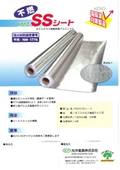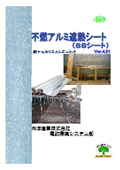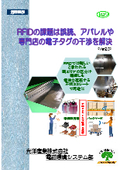Aluminum heat-insulating sheet, non-combustible aluminum heat-insulating sheet, aluminum non-combustible heat-insulating sheet.
Is comfort about temperature? Even if you increase the thickness of insulation and lower thermal conductivity, it won't necessarily lead to comfort. Used in the roof, walls, and floors of buildings, it demonstrates high heat insulation effectiveness!
● This is a non-combustible material with a fiberglass core and aluminum foil attached to both sides. ● A tape of the same material (such as SS tape) is used at the seams to maintain adhesion. Heat insulation measures for buildings in summer are key. ● In summer, roofs heat up due to solar electromagnetic waves, rising to around 55°C to 70°C. By covering them with SS sheets, radiant heat is reflected, protecting the building from radiant heat that insulation cannot guard against, creating a comfortable space that is less affected by outside temperatures. ● By covering with this product, radiant heat is reflected, protecting the building from radiant heat that insulation cannot guard against, creating a comfortable space that is less affected by outside temperatures. ● The fiberglass reinforced core with double-sided aluminum sheets demonstrates durability, making it less likely to crack from bending and improving workability on site. It also has waterproof performance, achieving moisture-proofing, heat insulation, and airtightness with a single layer of sheet even in fire compartments. ● According to alkali exposure tests conducted at our research institute, when applying this product directly to hardened concrete, no alkali corrosion is observed if primers, adhesives, etc., are used.
basic information
- When directly applying SS sheets to hardened concrete, using primers, adhesives, etc., will prevent alkali corrosion. - As a CO2 reduction measure, it can be used during renovations or new constructions in factories, stores, and offices, leading to reduced heating and cooling costs and improved environmental conditions. - It can be used on roofs, walls, and floors of buildings, providing a comfortable space and energy-saving effects. - Floor: It reflects 97% of the heat radiated from the floor, making the area underfoot and the entire floor comfortable. - Walls: It reflects 97% of the heat radiated from the outside, demonstrating high soundproofing and heat insulation effects, eliminating the need for waterproof sheets, and preventing the growth of bacteria and mold. - Ceiling: Used as an inner lining, it provides high soundproofing and heat insulation effects. - Due to its excellent durability, it can be easily used for cold and heat retention, storage, and duct and pipe insulation.
Price range
Delivery Time
Applications/Examples of results
● Wooden structures (new and existing) roofs, attics, walls, floors ● Existing folded plate roofs ● Heat insulation measures for outdoor air conditioning units ● Shielding for cables, connectors, etc.
Detailed information
-

Thermal insulation performance test method A thermocouple was placed on a gypsum board 25 cm away from an infrared heater, and the temperature changes were measured in two cases: when not covered with a sheet and when covered with an SS sheet or commercially available aluminum foil. Measurement time: every 10 seconds for 2 hours Room temperature: 18–20°C
-

Performance Sheet SS Sheet The SS sheet is a double-sided aluminum sheet that has obtained non-combustible certification, making it an excellent building material in terms of durability and workability.
-

Performance Table: Aluminum Foil (Comparison) It is practically impossible to install aluminum foil in buildings.
-

Regarding fireproof certification: Fireproof material certification (non-combustible: NM-1776) is required for construction under interior restrictions. 1) Fireproof materials are those defined or certified by the Minister of Land, Infrastructure, Transport and Tourism according to performance classifications of non-combustible, quasi-non-combustible, and flame-retardant. ● When subjected to heat from a typical fire, the following criteria must be met: ◎ It must not burn. ◎ It must not undergo harmful deformation, melting, cracking, or other damage that is hazardous from a fire safety perspective. ◎ It must not produce harmful smoke or gases that could impede evacuation. ● Each performance is defined by the time after heating begins. ◎ Non-combustible performance: 20 minutes after heating begins. ◎ Quasi-non-combustible performance: 10 minutes after heating begins. ◎ Flame-retardant performance: 5 minutes after heating begins. 2) Fireproof performance is certified based on the combination of the substrate material (as per Ministry of Construction Notification No. 1400, non-combustible materials are defined by amendments to Ministry of Construction Notification No. 1400 and Ministry of Land, Infrastructure, Transport and Tourism Notification No. 1178, as determined by the Minister of Land, Infrastructure, Transport and Tourism) and the construction method.
-

Alkali resistance test: standard SS sheet
-

Alkali Resistance Test: Contact with concrete slab for about 1 year SS sheets were affixed to the cured concrete using a primer and interior adhesive, and after leaving them for about six months, they were removed to check for signs of corrosion. As a result, there were no signs of corrosion after about six months. Therefore, when directly affixing SS sheets to concrete, it is advisable to insert a primer that does not corrode in alkaline conditions and maintains a nearly neutral pH. Primer: Special urethane-modified acrylic emulsion penetrating sealer Adhesive: Interior-grade chloroprene rubber adhesive (solvent-based) Adhesive: Acrylic emulsion adhesive for carpet tiles (water-based)
catalog(4)
Download All Catalogs


Recommended products
Distributors
Our mission is to add our unique ideas and know-how to the new materials that are continuously emerging, in order to meet the needs of various industries, and to propose them as new products with added functionalities. Our functional composite materials exhibit excellent and original features across various fields, including home appliances, precision equipment, medical devices, construction, and transportation, as well as in areas such as equipment parts, special rooms, and architectural panels, thereby serving everyone effectively. "Reflecting the times and exploring the next generation" is our pride in our continuous development capabilities that lead the industry. We offer a variety of electromagnetic wave countermeasure products. Furthermore, to carry out these measures effectively and efficiently, we have established a system that allows us to conduct electromagnetic wave environment measurements, field surveys, construction advice, and shielding work consistently. Technology is not born overnight. Our employees cherish a proactive attitude towards "technologies that no one is doing," "technologies that are deemed impossible," and "unique technologies." In development, not everything is successful; in fact, failures are more common. However, it is also true that the byproduct technologies born from challenges support our company today.













































